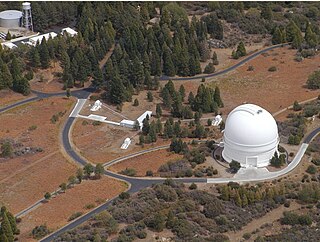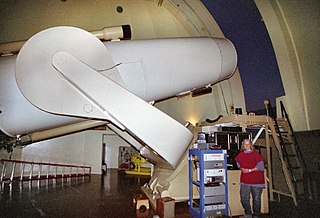
Jean Mueller (born 1950) is an American astronomer and discoverer of comets, minor planets, and a large number of supernovas at the U.S. Palomar Observatory in California. [1]

Jean Mueller (born 1950) is an American astronomer and discoverer of comets, minor planets, and a large number of supernovas at the U.S. Palomar Observatory in California. [1]
In 1983, she became the first woman to operate the historic Hooker telescope at Mt. Wilson Observatory and was the first woman hired as a telescope operator at Palomar Observatory in 1985.
The Second Palomar Observatory Sky Survey (POSS II) got under way in August 1985, with the first of the 14" photographic glass plates being pulled off the Palomar's Samuel Oschin telescope (then called the 48-inch Schmidt Camera). Jean Mueller was hired as the 48-Inch Night Assistant in July of that year, and worked in the capacity as observer and telescope operator for the duration. She took over 5500 photographic plates and had the honor of setting the telescope and removing the final plate from the historic Schmidt Camera on June 3, 2000, as well as discovering her last supernova, 2000cm, on that same night.
Jean Mueller spent hundreds of hours (in her spare time) scanning POSS II plates under high magnification looking for comets, fast-moving asteroids, and supernovae on an X/Y stage that held the 1 mm thick glass plates. Mueller would sometimes mark over a hundred galaxies recorded on a single POSS II plate to hunt for supernova candidates. She would then compare these plates with the first Palomar Sky Survey (POSS I) of similar fields. It was during the years of the POSS II project that Jean Mueller made all of her discoveries.

| 4257 Ubasti | August 23, 1987 |
| 4558 Janesick [1] | July 12, 1988 |
| 6569 Ondaatje | June 22, 1993 |
| 9162 Kwiila | July 29, 1987 |
| (11028) 1987 UW | October 18, 1987 |
| 11500 Tomaiyowit [2] | October 28, 1989 |
| 12711 Tukmit | January 19, 1991 |
| 16465 Basilrowe | March 24, 1990 |
| 19204 Joshuatree | June 21, 1992 |
| 24658 Misch | October 18, 1987 |
| (360191) 1988 TA [3] | October 5, 1988 |
| (408752) 1991 TB2 | 3 October 1991 |
| (412976) 1987 WC | 21 November 1987 |
| |
Working at Palomar Observatory, she discovered a total of 15 comets, including 7 periodic comets 120P/Mueller, 131P/Mueller, 136P/Mueller, 149P/Mueller, 173P/Mueller, 188P/LINEAR-Mueller, 190P/Mueller, and 8 non-periodic comets.
She is credited by the Minor Planet Center with the discovery of 13 numbered minor planets during 1987–1993, including several near-Earth objects such as the Apollo asteroids 4257 Ubasti, 9162 Kwiila, and 12711 Tukmit and the Amor asteroid 6569 Ondaatje. [2]
Mueller also discovered 107 (9 listed as co-discoveries) supernovae. [3]
The inner main-belt asteroid of the Hungaria family, 4031 Mueller, was named in honor of Jean Mueller for her astronomical discoveries. Discovered on February 12, 1985, by Carolyn Shoemaker at Palomar Observatory with the 18" Schmidt Camera, it was originally designated 1985 CL. [1] The official naming citation was published by the Minor Planet Center on 12 December 1989 ( M.P.C. 15576). [4]
Jean Mueller is an Advisor of the Meade 4M Community who supports her outreach activities.

Palomar Observatory is an astronomical research observatory in San Diego County, California, United States, in the Palomar Mountain Range. It is owned and operated by the California Institute of Technology (Caltech). Research time at the observatory is granted to Caltech and its research partners, which include the Jet Propulsion Laboratory (JPL), Yale University, and the National Optical Observatories of China.
Near-Earth Asteroid Tracking (NEAT) was a program run by NASA and the Jet Propulsion Laboratory, surveying the sky for near-Earth objects. NEAT was conducted from December 1995 until April 2007, at GEODSS on Hawaii, as well as at Palomar Observatory in California. With the discovery of more than 40 thousand minor planets, NEAT has been one of the most successful programs in this field, comparable to the Catalina Sky Survey, LONEOS and Mount Lemmon Survey.

Charles Thomas Kowal was an American astronomer known for his observations and discoveries in the Solar System. As a staff astronomer at Caltech's Mount Wilson and Palomar Mountain observatories between 1961 and 1984, he found the first of a new class of Solar System objects, the centaurs, discovered two moons of the planet Jupiter, and discovered or co-discovered a number of asteroids, comets and supernovae. He was awarded the James Craig Watson Medal for his contributions to astronomy in 1979.

Eleanor Francis "Glo" Helin was an American astronomer. She was principal investigator of the Near-Earth Asteroid Tracking (NEAT) program of NASA's Jet Propulsion Laboratory.

Hans-Emil Schuster is a German astronomer and a discoverer of minor planets and comets, who retired in October 1991. He worked at Hamburg Observatory at Bergedorf and European Southern Observatory (ESO), and was former acting director of La Silla Observatory. From 1982 he was married to Rosemarie Schuster née von Holt
2934 Aristophanes, provisional designation 4006 P-L, is a carbonaceous Veritasian asteroid from the outer regions of the asteroid belt, approximately 22 kilometers in diameter. It was discovered during the Palomar–Leiden survey in 1960, and later named after ancient Greek dramatist Aristophanes.
4065 Meinel, provisional designation 2820 P-L, is an asteroid from the inner regions of the asteroid belt, approximately 4 kilometers in diameter. It was discovered on 24 September 1960, by Dutch astronomer couple Ingrid and Cornelis van Houten on photographic plates taken by Dutch–American astronomer Tom Gehrels at Palomar Observatory, California. The asteroid was named for American astronomer Aden Meinel.
C. Michelle Olmstead is an American astronomer, asteroid discoverer and computer scientist.

The Samuel Oschin telescope, also called the Oschin Schmidt, is a 48-inch-aperture (1.22 m) Schmidt camera at the Palomar Observatory in northern San Diego County, California. It consists of a 49.75-inch Schmidt corrector plate and a 72-inch (f/2.5) mirror. The instrument is strictly a camera; there is no provision for an eyepiece to look through it. It originally used 10- and 14-inch glass photographic plates. Since the focal plane is curved, these plates had to be preformed in a special jig before being loaded into the camera.
5011 Ptah is a near-Earth object and potentially hazardous asteroid of the Apollo group. It was discovered by astronomers with the Palomar–Leiden survey on 24 September 1960. The rare O-type asteroid on an eccentric orbit measures approximately 1.6 kilometers in diameter. It was named after the Ancient Egyptian deity Ptah.
4031 Mueller, provisional designation 1985 CL, is a Hungaria asteroid from the inner regions of the asteroid belt, approximately 4 kilometers in diameter. It was discovered on 12 February 1985, by American astronomer Carolyn Shoemaker at Palomar Observatory, California, and named after astronomer Jean Mueller.

9905 Tiziano, provisional designation 4611 P-L, is an asteroid from the inner regions of the asteroid belt, approximately 5 kilometers in diameter. Discovered during the Palomar–Leiden survey in 1960, the asteroid was named after Italian Renaissance painter Titian.
10660 Felixhormuth, provisional designation 4348 T-1, is a background asteroid from the outer regions of the asteroid belt, approximately 7 kilometers in diameter. It was discovered on 26 March 1971, by Dutch astronomer couple Ingrid and Cornelis van Houten at Leiden, on photographic plates taken by Dutch–American astronomer Tom Gehrels at Palomar Observatory in California, United States. The asteroid was named after German astronomer Felix Hormuth.
3047 Goethe, provisional designation 6091 P-L, is a bright background asteroid from the central regions of the asteroid belt, approximately 6 kilometers in diameter. It was discovered on 24 September 1960, by Dutch astronomer couple Ingrid and Cornelis van Houten on photographic plates taken by Dutch–American astronomer Tom Gehrels at the Palomar Observatory in California, United States. The asteroid was named after German poet Johann Wolfgang von Goethe.
1924 Horus, provisional designation 4023 P-L, is a dark asteroid from the inner regions of the asteroid belt, approximately 12 kilometers in diameter. Discovered during the Palomar–Leiden survey in 1960, it was later named after Horus from Egyptian mythology.
1923 Osiris, provisional designation 4011 P-L, is a dark asteroid from the inner regions of the asteroid belt, approximately 13 kilometers in diameter. It was discovered on 24 September 1960, by Ingrid and Cornelis Johannes van Houten at Leiden, on photographic plates taken by Tom Gehrels at Palomar Observatory in the United States. It was named after the Egyptian god Osiris.

Puckett Observatory is a private astronomical observatory located in the state of Georgia. It is owned and operated by Tim Puckett. Its primary observation goals are the study of comets and the discovery of supernovae. To facilitate the latter goal it sponsors the Puckett Observatory World Supernova Search whose astronomers have discovered 369 supernovae.
The Palomar Transient Factory, was an astronomical survey using a wide-field survey camera designed to search for optical transient and variable sources such as variable stars, supernovae, asteroids and comets. The project completed commissioning in summer 2009, and continued until December 2012. It has since been succeeded by the Intermediate Palomar Transient Factory (iPTF), which itself transitioned to the Zwicky Transient Facility in 2017/18. All three surveys are registered at the MPC under the same observatory code for their astrometric observations.
The Palomar–Leiden survey (PLS) was a successful astronomical survey to study faint minor planets in a collaboration between the U.S Palomar Observatory and the Dutch Leiden Observatory, and resulted in the discovery of thousands of asteroids, including many Jupiter trojans.
Tenagra Observatory and Tenagra Observatory II are astronomical observatories in Cottage Grove, Oregon and Arizona. The observatories house heavily automated robotic telescopes.